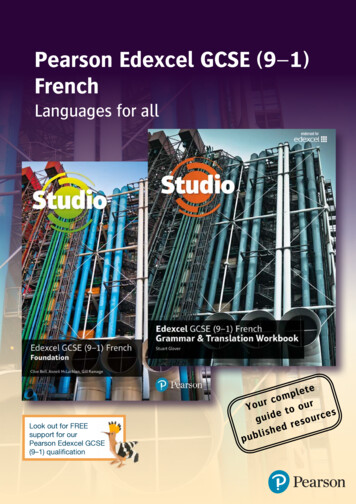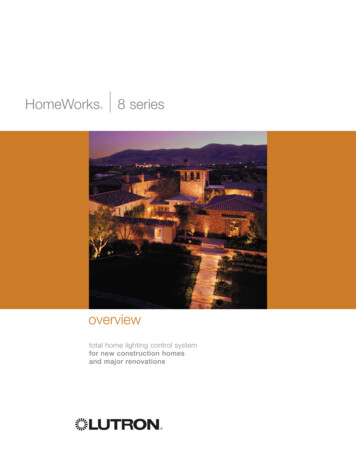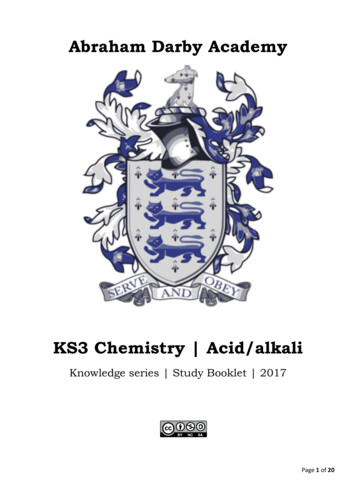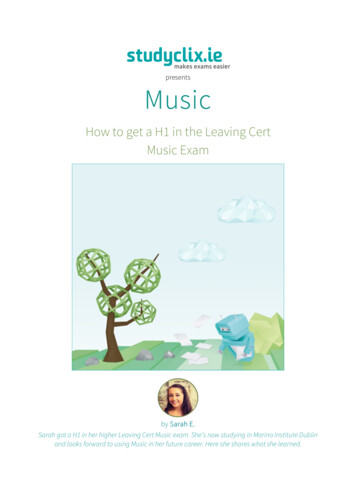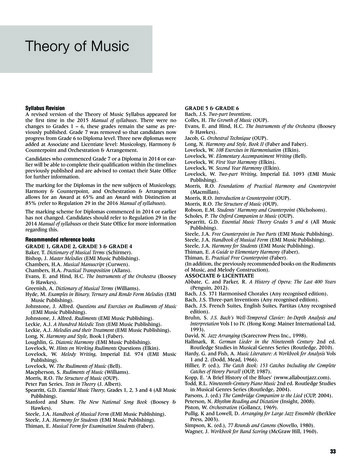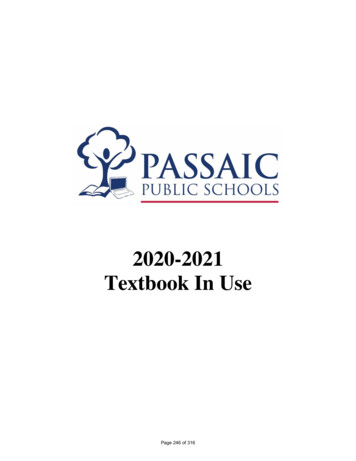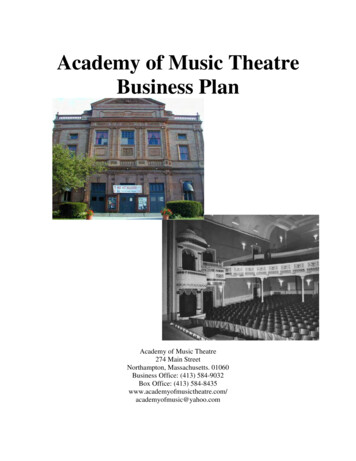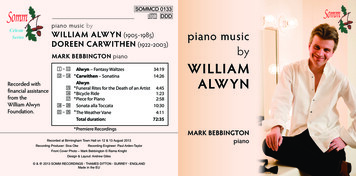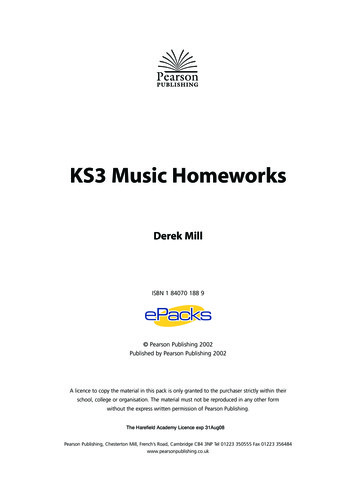
Transcription
The Harefield Academy Licence exp 31Aug08KS3 Music HomeworksABCDEFGHIJKLMNOPQRSTUVWXYZ 567890Derek MillISBN 1 84070 188 9 Pearson Publishing 2002Published by Pearson Publishing 2002A licence to copy the material in this pack is only granted to the purchaser strictly within theirschool, college or organisation. The material must not be reproduced in any other formwithout the express written permission of Pearson Publishing.The Harefield Academy Licence exp 31Aug08Pearson Publishing, Chesterton Mill, French’s Road, Cambridge CB4 3NP Tel 01223 350555 Fax 01223 356484www.pearsonpublishing.co.uk
The Harefield Academy Licence exp 31Aug08KS3 Music HomeworksIntroductionThis pack is designed to help music teachers who find setting homework on a regular basistime-consuming and a cumbersome burden. Often, it is also difficult to find homework that is of realbenefit to the student.Each homework sheet in this pack is designed to give maximum help to the student while creating onlythe minimum amount of assessment for the teacher. Often the worksheets contain enough homework formore than one week. In some cases, the homeworks may be used as work set during staff absence.Although the worksheets are self-contained, some are designed to be set consecutively, and so it issuggested that they are given to students in the correct order.How to use this packThe homeworks can be given to students for them to work through on their own. The best practice,however, is to use the homeworks as an integral part of the teaching process. Select a homeworkwhich is relevant to the material being covered in the lesson. Leave time at the end of the lesson tolook at what the homework entails and explain to the students what outcome is expected. In eachcase, the aim of the homework is to broaden students’ understanding of exactly how music isperformed or composed and to encourage and enable them to listen with greater understanding. Thecompanion pack, KS3 Music Listening Exercises (Pearson Publishing, 2002) may help with this. Forhomeworks which require research, make sure that, if students have no access to the Internet at home,they can use the school facilities.MarkingIn order to minimise the amount of marking for the teacher, many of the homeworks can be marked bythe students themselves at the start of the next lesson, with the teacher providing the answers. Somehomeworks can be followed up with a test of the material learnt. In these cases, the questions havebeen provided on a separate page. Where the work does require the teacher to do marking, it has beenkept to a minimum and if possible complete answers have been given. Teacher’s notes and answers areprovided on pages 43 to 52.A glossary of musical terms has been provided on pages 53 to 57, and those words which are listed in itare emboldened on the worksheets. It is suggested that a copy of the glossary is given to each student,or is made available in the classroom, at the beginning of the course for reference.Derek MillJune 2002The Harefield Academy Licence exp 31Aug08Pearson Publishing 01223 3505551
The Harefield Academy Licence exp 31Aug08KS3 Music HomeworksHomework 1Musical diagramsWritten music is simply a graph of soundLook at this music:This can be expressed as a graph:PitchTime passing in beatsMake a neat copy of the stave and graph above. Give the diagram the title ‘Written music is simply agraph of sound’. When you have finished, draw your own graph and write it out as music.The keyboard and the stave Draw the keyboard diagram below onto a sheet of A3 paper. Each white note should be exactly 22millimetres wide. Each black note should be one centimetre wide. Copy the stave below underneath your drawing of the keyboard. Each note on the stave should lineup exactly with the correct white note and be on the right line or space on the stave.C D E F G A B C D E F G A B C D EThe Harefield Academy Licence exp 31Aug08Pearson Publishing 01223 3505552
The Harefield Academy Licence exp 31Aug08KS3 Music HomeworksHomework 2Five-finger keyboard practiceThe following method will help you to develop a sense of rhythm and melody. The five-finger position isindicated by ‘Thumb on C’ or ‘Thumb on G’, as shown below:F G A B C D E F G A B1234F G A B C D E F G A B512345To do the practice, you need to understand the following codes: Each number (1 2 3 4 5) represents the finger to be played by the right hand for one beat.Play the first, then the second, then the third, then the fourth, then the fifth finger. Each noteshould last one beat. A repeated number means you should play the same finger again.Play the third finger four times.3333 A dash after a number means the finger should be held for another beat.1 1Hold the first finger for two beats, twice.2Hold the second finger for four beats.1 4Hold the first finger for three beats, then play the fourth finger for one beat.Two numbers underlined mean play the notes evenly within the same beat.Play the first and second fingers twice for half a beat each. Play the thirdfinger for one beat, then the first finger for one beat.12 12 3 1 Four numbers underlined together means play the four notes evenly within one beat.Play fingers one, two, three and four evenly in one beat, then play the fifthfinger three times, one beat for each note.1234 5 5 5 The straight line represents a bar line. The time signature will be 4 per bar or 3 per bar. A doublebar line usually indicates the end of the music or the end of a section of music. It is rather like afull stop in a sentence, as shown in the exercises below. ExercisesYou need a keyboard or a piano for these tasks. Alternatively, if you have no instrument available, youcan use the diagram of a keyboard which you drew in Homework 1.1Try the following exercises:abc Thumb on A. 1 3 5 1 3 5 4 3 2 5 3 1 5 3 1 2 3 1 Thumb on G. 12 12 12 12 4 3 2 12 12 12 12 4 3 5 43 21 43 21 2 3 2 43 21 43 21 2 3 1 Thumb on C. 1 2 3 4 1 2 3 4 5 5 2 1 2 3 4 1 2 3 4 2 5 1The Harefield Academy Licence exp 31Aug08Pearson Publishing 01223 3505553
The Harefield Academy Licence exp 31Aug08KS3 Music Homeworks2Homework 2 (continued)When you have finished, write out each exercise as music on the staves below.abcThe Harefield Academy Licence exp 31Aug08Pearson Publishing 01223 3505554
The Harefield Academy Licence exp 31Aug08KS3 Music HomeworksHomework 3Major scalesA semitone is the distance between any twonotes on a keyboard next door to one another.Generally this means moving from a naturalnote to the sharp or flat directly above or below.A tone is a distance of two semitones.SemitoneC D EF G A B C D EC D ESemitoneSemitoneF G A B C D EToneToneAll major scales use eight consecutive letters. There is no letter missing and no letter is used twice.A semitone in a scale is always from one letter to the next. All major scales use exactly the same patternof tones and semitones: Tone, Tone, Semitone, Tone, Tone, Tone, Semitone. The following letters are thesame note on the keyboard:b#C and BbB and C#F and EE and FNotes and chords are often numbered in Roman numerals (I, II, III, etc), as shown on the chart on page 6.They are also often labelled with a technical name, for example tonic, supertonic, submediant, etc.QuestionsUsing the chart on the next page, answer the following questions.1Fill in the gaps below. The first one has been done for you:ScaleNotea G majorAb.b B majorTechnical nameScaleNotebSupertonicc D majorMediantd B majorTechnical namebA#B.2Which major scale has three sharps? .3Which major scale has four flats?.4Write out the following scales on manuscript paper. Remember that the sharp or flat sign goesbefore the note, on the same line or space.aD majorbbE majorcE majordbB major5Which notes in G major are a semitone apart?.6Look at the scales as a whole. There is a pattern to the sequence of scales.aWhich note of the sharp scales provides the start note of the next scale? .bWhich note of the flat scales provides the start note of the next scale? .The Harefield Academy Licence exp 31Aug08Pearson Publishing 01223 3505555
The Harefield Academy Licence exp 31Aug08KS3 Music HomeworksHomework 3 (continued)Table of scalesThis table shows the technical names for a scale.Roman numeralIIIIIIIVVTechnical rn of tones/semitones in scaleAn example: C majorToneCToneDSemitoneEToneFVIISubmediant Leading noteToneGVIIToneATonicSemitoneBCScales using sharps (#)Read this table from left to right. It shows some major scales which have sharps. Compare it with thetable above.G majorGABCDEF#GD majorDEF#GABC#DA majorABC#DEF#G#AE majorEF#G#ABC#D#EB majorBC#D#EF#G#A#BF# majorF#G#A#BC#D#E#F#C# majorC#D#E#F#G#A#B#C#Scales using flats (b)Read this table from left to right. It shows some major scales which have flats. Compare it with the tableat the top of the page.F majorFGABbCDEFBb majorBbCDEbFGABbEb majorEbFGAbBbCDEbAb majorAbBbCDbEbFGAbDb majorDbEbFGbAbBbCDbGb majorGbAbBbCbDbEbFGbCb majorCbDbEbFbGbAbBbCbThe Harefield Academy Licence exp 31Aug08Pearson Publishing 01223 3505556
The Harefield Academy Licence exp 31Aug08KS3 Music HomeworksHomework 4Fingering for keyboard scales32Scales are part of the basic vocabulary of a musician on any instrument.Instant recognition of scales is useful in both performance and composition.145Practise the fingering for the following scales. You can either use a realkeyboard, or use the diagram you drew for Homework 1. Ask your teacherto demonstrate the fingering before you start. Using the right hand,1 Thumb, 2 Index finger, 3 Middle finger, 4 Ring finger,5 Little finger. For example, C1 means play C with your thumb.Major 3F 4##G1A2B3C 4D5Dmajor:D1E2F 3###########D1E2F 3G 4A5Amajor:A1B2C 3G 3A1B2C 3D 4E5Emajor:E1F 2#D 3E1F 2G 3A 4B5Bmajor:B1C G2A3B4C1D2DMinor (harmonic) scalesIn each of these scales, watch out for the stretch between the sixth and seventh notes. It can be easy tomiss the correct notes unless you think carefully.#A5Aminor:A1B2C3D1E2F3G 4##G3A1B2C3D 4E5Eminor:E1F 2###D3E1F 2G3A 4B5Bminor:B1C 2b#bb#bbC 4D5Dminor:D1E2F3G1A2B3C1D2E3F F4Fminor:F1G2A3The Harefield Academy Licence exp 31Aug08Pearson Publishing 01223 3505557
The Harefield Academy Licence exp 31Aug08KS3 Music HomeworksHomework 5Why we use different scalesMany pieces of music are based on scales. A scale is an arrangement of notes in ascending ordescending order of pitch. The distances between the notes are called semitones and tones. When weuse a particular scale, we say that the music is in that key. For example, if music is written using notesfrom the scale of D major, then we say it is in the key of D major. Read through the followinginformation and answer the questions below.MoodThe mood of the music is greatly affected by the type of scale that is being used. It is possible to writemusic using any type of scale for any mood or emotion, so the following statements are generalisations,but are a useful starting point: Major scale – bright, happy, majestic, victorious music Minor scale – mournful, dramatic, sad, spooky music Whole tone scale – mysterious, ghostly, magical music Pentatonic scale – Scottish, Chinese, Irish folk music Chromatic scale – strange, weird, comedy, creeping, shock, humorous music.The type of scale chosen for any style of music is often the starting point in creating the mood, althoughit is only one element that will help. Because a great deal of music is based in singing, it makes adifference where the music is pitched. Try to sing a simple tune, for example Happy Birthday, starting onthe note G. This will put the music in the key of C major. You may find that this is too high or too lowfor your voice. If you start the tune on the note C, you will be in the key of F major. This may make thetune much easier to sing, depending on the pitch range of your voice. Different instruments play moreeasily using different scales, so composers sometimes write music that is suited to the scales which soundbest on the instrument they are writing for.Having said all this, it is also more interesting to use different scales. If every piece of music was writtenusing the scale of C, (major, minor, or another pattern) then music would soon get rather boring.KeyThe key in which a piece begins has a very strong pull on the ear of the listener. In many pieces ofmusic, the composer chooses to begin and end in the same key. Some composers ‘lift’ the key at the endof a piece by a step or more. This adds to the drama and excitement of the music.Questions Listen to the songs you have been set. Record the name, artist and key in a chart like the one below.An example has been given for you. Listen carefully to the songs and see if you can hear any points where the music rises to a new key.This is sometimes near the end of the music, in the last verse or chorus. Record this information inthe last column of the chart.Name of songYellow SubmarineArtistThe BeatlesScale used(major/minor)MajorIs there a change ofkey near the end?NoThe Harefield Academy Licence exp 31Aug08Pearson Publishing 01223 3505558
The Harefield Academy Licence exp 31Aug08KS3 Music HomeworksHomework 6The BeatlesTry to answer the following questions. You can use the Internet, the school library, or you could ask yourparents or grandparents.1Name the four members of The Beatles.2From which city in the UK did The Beatles come?.3What was the first Beatles single to reach Number One in the UK charts?.4Who was the manager of The Beatles from 1962 to 1967?.5What was the last album released by The Beatles (not including compilations and re-releases)?.6Which former Beatle formed a band called Wings?.7Which member of The Beatles was shot outside his home and killed in 1980?.8What are the Red Album and the Blue Album? When were they made?.9Which member of The Beatles died inNovember 2001?.10 Which member of The Beatles led the finale atThe Party at the Palace during the Queen’s JubileePop Concert in 2002?.The BeatlesThe Harefield Academy Licence exp 31Aug08Pearson Publishing 01223 3505559
The Harefield Academy Licence exp 31Aug08KS3 Music HomeworksHomework 7Film music by John WilliamsThe American composer John Williams has written music for many of the mostwell-known films over the last 40 years or so.SOUNDTRACKListed below are a number of well-known films. Research in the school library, onthe Internet, in books and magazines or ask your parents or grandparents, etcto complete these tasks:1Tick the boxes next to those films that John Williams composed.2Find out the composer of the films that you have not ticked, and write thename in the ‘Composer’ column.The following Web sites may help: http://www.classicalrecordings.com/johnwilliams/ ml(use the alphabetical listing at the right-hand side of the page) http://www.filmtracks.com/ http://www.soundtrack.net/FilmTickComposer1 The Magnificent Seven (1960).2 The Good, the Bad and the Ugly (1966).3 Close Encounters of the Third Kind (1977).4 Star Wars (1977).5 Superman: The Movie (1978).6 ET The Extra Terrestrial (1982).7 Crocodile Dundee (1986).8 James Bond – The Living Daylights (1987).9 Sister Act (1992).10 Home Alone (1990).11 Beauty and the Beast (1991).12 Hook (1991).13 Jurassic Park (1993).14 The Lion King (1994).15 Titanic (1997).16 Harry Potter and the Philosopher’s Stone (2001).The Harefield Academy Licence exp 31Aug08Pearson Publishing 01223 35055510
The Harefield Academy Licence exp 31Aug08KS3 Music HomeworksHomework 8Vowel soundsSinging will improve with practice! Find somewhere on yourown to do this work.All singers have to overcome any shyness and be preparedto look a bit odd. Watch any singer on musicprogrammes on television, and you will see thempulling all sorts of funny faces. Sometimes this isto help them get a good sound; sometimes it isjust because they are pulling funny faces!You may feel a bit silly at first, but your singing willimprove with practice like this.Always keep your head up and do not drop your jawonto your chest.BreathingTake a really deep breath and let out a long, quiet, lownote. Do this a few times, gradually letting the noteswell in volume. Do not run out of breath: always keep a little in reserveso your note will not lose its pitch and go flat.VowelsPractise the following sounds separately, stopping after each one: ooh ah ay eeAs you change from one sound to the next, feel your face gradually move backwards, your cheeksslowly rising.Changing soundsPractise each sound separately and then change from one to the other smoothly, without any gaps. ooh – Push the lips forward. ah – Drop the jaw slightly. ay – Drop the jaw lower and further back. ee – Change to a smiling face with the jaw back and the cheeks lifted.‘Ooh’ and ‘ee’Practise changing slowly and smoothly between ooh and ee; you should feel your face moving a greatdeal while you do this. Try changing faster while keeping a good sound. Try this on different notes ofthe scale.The Harefield Academy Licence exp 31Aug08Pearson Publishing 01223 35055511
The Harefield Academy Licence exp 31Aug08KS3 Music HomeworksHomework 9Breath controlSinging will improve with practice! Find somewhere on your own do this work. You will need a watchwith a second hand. Try to repeat these exercises once or twice during the week. It is worth continuingto practise them on a regular basis to improve.ExercisesBreath control is an essential part of producing a good sound when singing. The following exercisesinvolve humming some low notes. When you do this, you should feel the note resonate in your throatand chest. You may find that your nose tickles and you sneeze too! If you feel dizzy (although youshouldn’t), stop and have a break. Hum the lowest note you can, very quietly. Hold it for 15 seconds, keeping the volume the same,then take a few gentle breaths. Repeat this three or four times. Hum the note again, this time getting louder over the 15 seconds. You use breath more quicklywhen you sing louder, so you may run out. Hum 15 separate one-second notes in one breath. Drop your jaw downwards slightly, withoutopening your mouth, while you sing. You should find that the note resonates more as you progress. Hum 30 half-beat (quaver) notes in 15 seconds, at the same volume, without taking a breath. Hum 30 half-beat (quaver) notes in 15 seconds, gradually getting louder, without taking a breath. Hum 60 quarter-beat (semiquaver) notes in 15 seconds without taking a breath. Keep the volumethe same throughout. Hum 60 quarter-beat (semiquaver) notes in 15 seconds,gradually getting louder, without taking a breath. This shouldreally stretch your breath control.PerformingWatch any television programme which shows singers performing.Look at the way the singers breathe when they are singing. Noticethe rise and fall of the chest as they use the air supplied from thelungs. Notice also the shape of the mouth and the whole face asthey produce the different consonant and vowel sounds.Be really critical. In your opinion, which singers use good breathcontrol to produce the sound? List some below. (Remember, somesingers may be miming to a recording.)Performers who:put energy intotheir singingare ‘lazy’ aboutsinging (Poorface shapes)have poor diction(It is hard to hear thewords properly)have goodbreath control.The Harefield Academy Licence exp 31Aug08Pearson Publishing 01223 35055512
The Harefield Academy Licence exp 31Aug08KS3 Music HomeworksHomework 10Named compositions – 1There are many pieces of music that are known by a particular name.Using the school library, the Internet, music books and dictionaries, find thenames of the composers for the following pieces. Also, and this is just asimportant, try to find out why each piece has such a name. Listening to themusic may also help.1MessiahComposer:.Reason for title: .2‘Moonlight’ SonataGeorg Frideric HandelComposer: .Reason for title:.31812 OvertureComposer: .Reason for title:.4The Hebrides Overture (‘Fingal’s Cave’)Composer: .Reason for title:.5The ‘New World’ SymphonyComposer: .Reason for title:.6The ‘Leningrad’ SymphonyComposer: .Reason for title:.The Harefield Academy Licence exp 31Aug08Pearson Publishing 01223 35055513
The Harefield Academy Licence exp 31Aug08KS3 Music HomeworksHomework 11Named compositions – 2There are many pieces of music that are known by a particular name.Using the school library, the Internet, music books and dictionaries, findthe names of the composers for the following pieces. Also, and this isjust as important, try to find out why each piece has such a name.Listening to the music may also help.1The ‘Eroica’ SymphonyComposer:.Reason for title: .2The ‘Prague’ SymphonyWolfgang Amadeus MozartComposer: .Reason for title:.3The ‘Devil’s Trill’ SonataComposer: .Reason for title:.4The ‘Italian’ SymphonyComposer: .Reason for title:.5The Water MusicComposer: .Reason for title:.6Für EliseComposer: .Reason for title:.The Harefield Academy Licence exp 31Aug08Pearson Publishing 01223 35055514
The Harefield Academy Licence exp 31Aug08KS3 Music HomeworksHomework 12Named compositions – 3Here are some more pieces of music which are known by a particular name.Using the school library, the Internet, music books and dictionaries, find thenames of the composers for the following pieces. Also, and this is just asimportant, try to find out why each piece has s
kept to a minimum and if possible complete answers have been given. Teacher's notes and answers are provided on pages 43 to 52. A glossary of musical terms has been provided on pages 53 to 57, and those words which are listed in it are emboldened on the worksheets. It is suggested that a copy of the glossary is given to each student,
